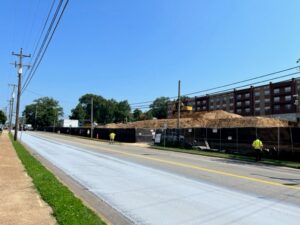
Roads can get very hot. Phoenix routinely records 180-degree pavement during its hottest days, and Nashville has seen 160-degree surfaces.
Traditional dark pavement captures between 80% and 95% of sunlight, which can then be released back into the air as heat, contributing to one of the primary causes of the urban heat island effect.
Nashville is now testing whether a possible solution is “cool pavement,” a light-colored coating that reflects sunlight and heat.
“We, as a city, have to be looking at all of these different approaches to see what we can do to combat this,” said Cortnye Stone, a spokesperson for the Nashville Department of Transportation and Multimodal Infrastructure.
More: With fewer trees and more concrete, Nashville is heating up. What’s the plan?
Last week, the department painted a layer of CoolSeal on a block of Fifth Street in East Nashville.
 Courtesy Nashville Department of Transportation and Multimodal Infrastructure
Courtesy Nashville Department of Transportation and Multimodal Infrastructure A section of road is covered in ‘cool pavement’ at 750 South Fifth Street in Nashville.
The city will now study the pros and cons of the material for the next few months.
So far, the results seem promising, especially in reducing nighttime heat. The city has recorded surface temperatures about 10 to 12 degrees cooler than nearby conventional pavement, according to Stone.
“As long as we are happy with the results, we are going to look at where we can apply it next,” Stone said.
There are additional benefits to cool pavement. Light-colored roads better reflect streetlights, too, so the city could safely reduce street lighting to save energy and reduce light pollution. Reducing heat also lowers some types of air pollution and cools water runoff.
But there could be some consequences with cool pavement, including a higher life-cycle amount of carbon dioxide emissions than conventional materials if not offset with less cement. People walking near cool pavement can even become victims of some of that reflected sunlight, so researchers warn cool pavement must be placed strategically, reported Inside Climate News.
If the project proves largely successful, then the city will next target roads in the hottest parts of Nashville.

